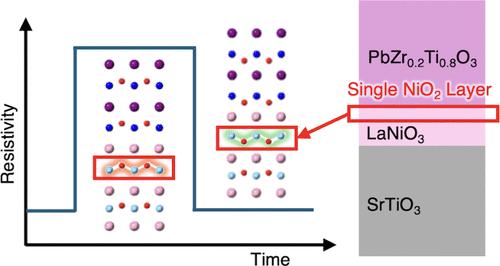Polarization-Controlled Structural Modulation in the Single Atomic Layer at the PbZr0.2Ti0.8O3/LaNiO3 Interface
IF 9.1
1区 材料科学
Q1 CHEMISTRY, MULTIDISCIPLINARY
引用次数: 0
Abstract
Conductivity modulation via ferroelectric polarization coupling with LaNiO3 (LNO) is demonstrated at an epitaxial ferroelectric–LNO interface. Conductivity measurements, varying the thickness of the LNO channel, show that this phenomenon is confined to a few atomic layers at the interface. Combining in situ biasing and off-axis holography, we mapped out electrostatic potentials at the PbZr0.2Ti0.8O3(PZT)/LNO/SrTiO3(STO) heterostructure upon polarization switching. Using aberration-corrected STEM, the interfacial atomic structures were investigated for the two different PZT polarization states. Polarization in PZT induces a significant change in the in-plane O–Ni–O bond angles, with a 37° modulation in the topmost 1 or 2 LNO unit cells, driven by strain in the oxygen sublattice for the two opposite polarization directions in PZT. Both oxygen and cation sublattices exhibit strain responses exceeding 10% upon switching. This atomic-layer structural modulation highlights a mechanism for functional oxide heterostructure development, offering pathways for advancements in nonvolatile memory, sensors, and energy-efficient transistors.

PbZr0.2Ti0.8O3/LaNiO3界面单原子层偏振控制结构调制
在外延铁电- LNO界面上,通过铁电极化耦合与LaNiO3 (LNO)实现了电导率调制。改变LNO通道厚度的电导率测量表明,这种现象仅限于界面上的几个原子层。结合原位偏置和离轴全息技术,我们绘制了偏振开关时PbZr0.2Ti0.8O3(PZT)/LNO/SrTiO3(STO)异质结构的静电电位图。利用像差校正的STEM,研究了两种不同偏振态PZT的界面原子结构。PZT中的极化引起了平面内O-Ni-O键角的显著变化,在氧亚晶格中的应变驱动下,PZT中两个相反极化方向的O-Ni-O键角在最上面的1或2 LNO单元胞中发生37°调制。氧亚晶格和阳离子亚晶格在开关时均表现出超过10%的应变响应。这种原子层结构调制强调了功能氧化物异质结构发展的机制,为非易失性存储器、传感器和节能晶体管的进步提供了途径。
本文章由计算机程序翻译,如有差异,请以英文原文为准。
求助全文
约1分钟内获得全文
求助全文
来源期刊

Nano Letters
工程技术-材料科学:综合
CiteScore
16.80
自引率
2.80%
发文量
1182
审稿时长
1.4 months
期刊介绍:
Nano Letters serves as a dynamic platform for promptly disseminating original results in fundamental, applied, and emerging research across all facets of nanoscience and nanotechnology. A pivotal criterion for inclusion within Nano Letters is the convergence of at least two different areas or disciplines, ensuring a rich interdisciplinary scope. The journal is dedicated to fostering exploration in diverse areas, including:
- Experimental and theoretical findings on physical, chemical, and biological phenomena at the nanoscale
- Synthesis, characterization, and processing of organic, inorganic, polymer, and hybrid nanomaterials through physical, chemical, and biological methodologies
- Modeling and simulation of synthetic, assembly, and interaction processes
- Realization of integrated nanostructures and nano-engineered devices exhibiting advanced performance
- Applications of nanoscale materials in living and environmental systems
Nano Letters is committed to advancing and showcasing groundbreaking research that intersects various domains, fostering innovation and collaboration in the ever-evolving field of nanoscience and nanotechnology.
 求助内容:
求助内容: 应助结果提醒方式:
应助结果提醒方式:


